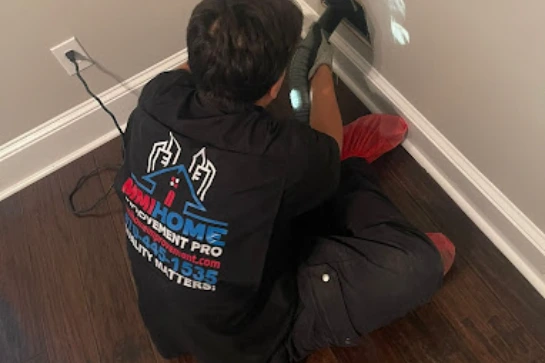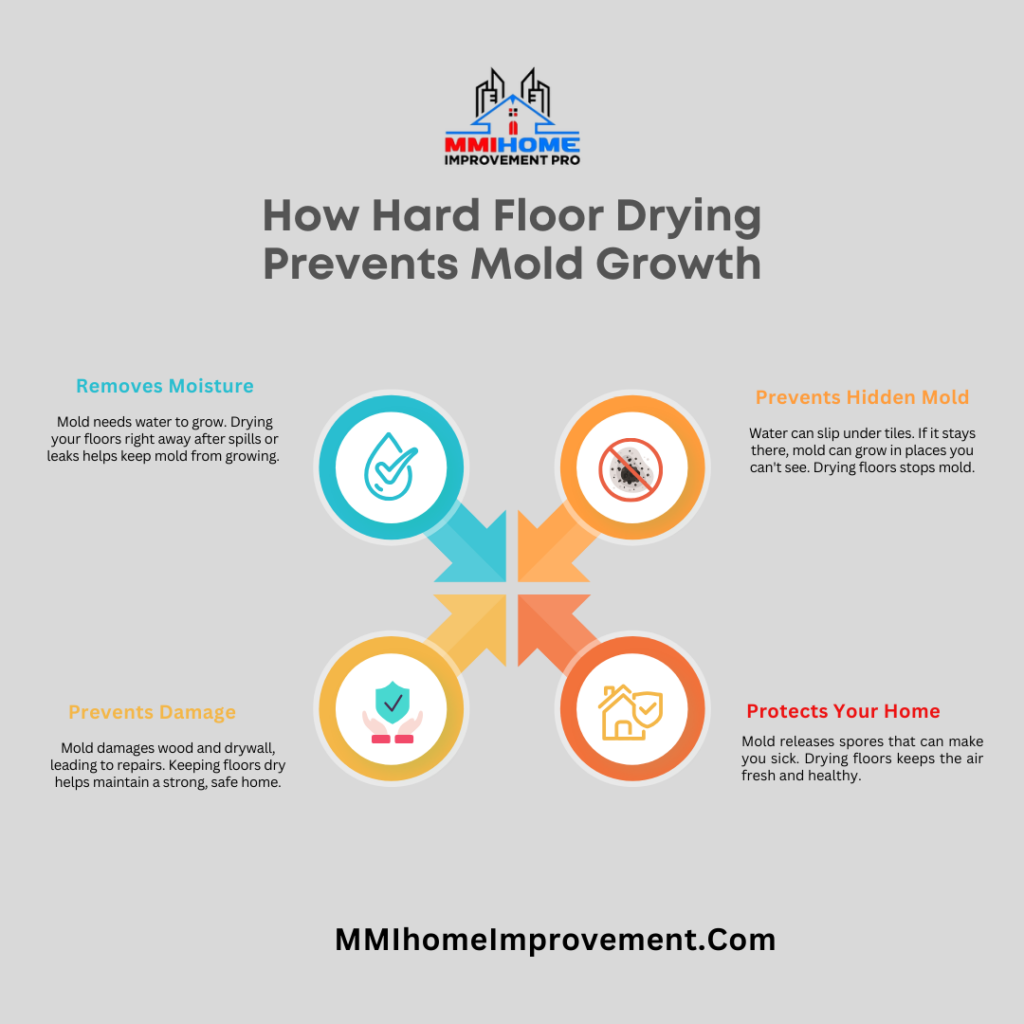One time, we had a small water leak in our kitchen. I cleaned it up pretty well with a mop and a fan. But a few weeks later, I noticed a weird smell and dark spots started showing up near the floorboards. Mold was growing because I didn’t dry the floors properly. That was a big lesson for me! Mold grows fast when there’s moisture, and mopping up water isn’t always enough. If you’re wondering, “Does hard floor drying prevent mold growth?” The answer is yes! Let me tell you what I’ve learned about drying floors the right way to keep mold away for good.
For the best Mold Air Duct Cleaning in Duluth, contact MMI Home Improvement Pro, as they are an efficient service provider

Understanding Mold and Its Causes
Mold loves damp, dark, and humid places. It starts as tiny spores in the air that settle on wet surfaces. Once it finds a place to grow, mold can spread quickly, feeding on wood, walls, and even dust on hard floors.
Some common causes of mold include:
- Water spills or flooding: If water isn’t cleaned immediately, it can get into cracks and corners, where mold can grow.
- High humidity: When the air is too moist (above 60%), water can condense on floors, making a good place for mold to grow.
- Leaks or plumbing problems: Hidden leaks under floors or walls can cause mold to grow without you even noticing.
Drying your floors quickly after they get wet is one of the best ways to stop mold before it starts.
How Hard Floor Drying Prevents Mold Growth
1. Removes Moisture, the Key to Mold Growth
Mold needs moisture to grow. Drying your hard floors right away removes the water that mold needs to form. This is especially important after spills or leaks.
2. Stops Mold from Growing in Hidden Areas
Water can seep under floors like tile or wood, where it’s hard to see. If the water isn’t dried, mold can grow in these hidden spots. Drying the floors properly keeps the water from staying where it shouldn’t.
3. Prevents Damage to Your Home
Mold doesn’t just grow on floors—it can also damage the structure of your home. It can weaken wood and drywall, leading to expensive repairs. Drying the floors properly helps keep your home safe and in good condition.
4. Keeps Air Clean
Mold spreads through the air in your home, releasing tiny spores that can make you sick. By drying your floors well, you reduce the chance of mold spreading and help keep the air in your home fresh and clean.

Use the below code to embed this infographic
Best Practices for Drying Hard Floors
To make sure you stop mold before it starts, follow these tips for drying your floors:
- Act Fast
The quicker you clean up the water, the better. Mold can start growing within 1 to 2 days, so always dry spills as soon as they happen.
- Use the Right Tools
- Mops and towels: Great for cleaning up spills on the surface.
- Fans or blowers: Help air move around and dry the floor faster.
- Dehumidifiers: These can reduce moisture in the air, which is especially useful in damp rooms.
- Wet-dry vacuums: These can suck up water from cracks and hard-to-reach spots.
- Check for Hidden Water
Look around the edges and seams of your floor to make sure no water is trapped. If you have wood or laminate floors, lift sections to check underneath.
- Keep the Air Flowing
Good airflow helps dry things faster and prevents moisture from remaining. Open windows, use fans, or run your HVAC system to keep the air moving.
- Watch Humidity Levels
Keep the humidity in your home between 30% and 50%. A hygrometer is a tool that can measure humidity, helping you keep it in the correct range.
Hard Floor Types and Mold Prevention
Different types of hard floors need different drying methods:
1. Tile Floors
The tile is water-resistant, but the grout between tiles can soak up water and grow mold. Use a wet vacuum to suck up water and clean the grout with a mold-fighting solution.
2. Hardwood Floors
Wood can soak up water quickly, making mold easier to grow. Dry spills right away with a towel, and try not to use too much water when cleaning. For serious cases, you might need to call a professional.
3. Laminate Floors
Laminate floors can warp when wet, so avoid using too much water. Dry them quickly using fans or dehumidifiers.
4. Vinyl Floors
Vinyl is water-resistant but must be dried quickly to keep moisture from getting under the surface.
When to Call a Professional
Sometimes, you might need extra help to make sure your floors are properly dried. Call a professional if:
- The water damage is large or spread out.
- Your floors still feel damp after drying for a long time.
- You smell a musty odor or see mold.
- Water from flooding or sewage has gotten into your home.
Professionals use tools like big fans, moisture detectors, and cleaning products to make sure your floors are really dry and mold-free.
Proactive Measures to Prevent Mold Growth
Drying your floors is important, but it works best when you also take these extra steps:
- Regular checks: Look for leaks or cracks in your floors and walls.
- Waterproofing: Seal cracks to keep water out.
- Cleaning often: Dirt and dust can trap moisture, so keep your floors clean.
- Teach everyone in your house: Make sure everyone knows the importance of cleaning up spills right away.
Summary
So, does hard floor drying prevent mold growth? Yes! By drying your floors quickly and completely, you remove the moisture mold needs to grow. Drying your floors properly and taking other preventive steps will help keep your home mold-free and healthy. So, start drying those floors today, and you’ll save yourself from mold problems later!

